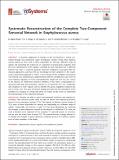Files in this item
Systematic reconstruction of the complete two-component sensorial network in Staphylococcus aureus
Item metadata
| dc.contributor.author | Rapun-Araiz, B. | |
| dc.contributor.author | Haag, A. F. | |
| dc.contributor.author | Cesare, V. De | |
| dc.contributor.author | Gil, C. | |
| dc.contributor.author | Dorado-Morales, P. | |
| dc.contributor.author | Penades, J. R. | |
| dc.contributor.author | Lasa, I. | |
| dc.contributor.editor | Methe, Barbara | |
| dc.date.accessioned | 2021-12-01T15:30:23Z | |
| dc.date.available | 2021-12-01T15:30:23Z | |
| dc.date.issued | 2020-08-25 | |
| dc.identifier | 276906559 | |
| dc.identifier | e84d034d-2a14-44e1-b704-e1df3c264aba | |
| dc.identifier | 85089851859 | |
| dc.identifier.citation | Rapun-Araiz , B , Haag , A F , Cesare , V D , Gil , C , Dorado-Morales , P , Penades , J R , Lasa , I & Methe , B (ed.) 2020 , ' Systematic reconstruction of the complete two-component sensorial network in Staphylococcus aureus ' , mSystems , vol. 5 , no. 4 , e00511-20 . https://doi.org/10.1128/msystems.00511-20 | en |
| dc.identifier.issn | 2379-5077 | |
| dc.identifier.other | Bibtex: Rapun_Araiz_2020 | |
| dc.identifier.other | ORCID: /0000-0002-6783-0231/work/104252952 | |
| dc.identifier.uri | https://hdl.handle.net/10023/24464 | |
| dc.description | This work was supported by the Spanish Ministry of Economy and Competitiveness grant BIO2017-83035-R (AEI/FEDER, EU) awarded to I.L. and a Tenovus Scotland project grant S16/12 awarded to A.F.H. A.F.H. is supported by the European Research Council (ERC) under the European Union’s Horizon 2020 research and innovation program awarded to J.R.P. (grant agreement ERC-ADG-2014 proposal no. 670932 Dut-signal from EU). V.D.C. was supported by the Medical Research Council (MRC grant MC_UU_12016) and the pharmaceutical companies supporting the Division of Signal Transduction Therapy (Boehringer Ingelheim, GlaxoSmithKline, and Merck KGaA). | en |
| dc.description.abstract | In bacteria, adaptation to changes in the environment is mainly controlled through two-component signal transduction systems (TCSs). Most bacteria contain dozens of TCSs, each of them responsible for sensing a different range of signals and controlling the expression of a repertoire of target genes (regulon). Over the years, identification of the regulon controlled by each individual TCS in different bacteria has been a recurrent question. However, limitations associated with the classical approaches used have left our knowledge far from complete. In this report, using a pioneering approach in which a strain devoid of the complete nonessential TCS network was systematically complemented with the constitutively active form of each response regulator, we have reconstituted the regulon of each TCS of S. aureus in the absence of interference between members of the family. Transcriptome sequencing (RNA-Seq) and proteomics allowed us to determine the size, complexity, and insulation of each regulon and to identify the genes regulated exclusively by one or many TCSs. This gain-of-function strategy provides the first description of the complete TCS regulon in a living cell, which we expect will be useful to understand the pathobiology of this important pathogen. | |
| dc.format.extent | 16 | |
| dc.format.extent | 2256813 | |
| dc.language.iso | eng | |
| dc.relation.ispartof | mSystems | en |
| dc.subject | Staphylococcus aureus | en |
| dc.subject | Regulon | en |
| dc.subject | Two-component systems | en |
| dc.subject | QR Microbiology | en |
| dc.subject | DAS | en |
| dc.subject.lcc | QR | en |
| dc.title | Systematic reconstruction of the complete two-component sensorial network in Staphylococcus aureus | en |
| dc.type | Journal article | en |
| dc.contributor.institution | University of St Andrews. School of Medicine | en |
| dc.identifier.doi | 10.1128/msystems.00511-20 | |
| dc.description.status | Peer reviewed | en |
This item appears in the following Collection(s)
Items in the St Andrews Research Repository are protected by copyright, with all rights reserved, unless otherwise indicated.

